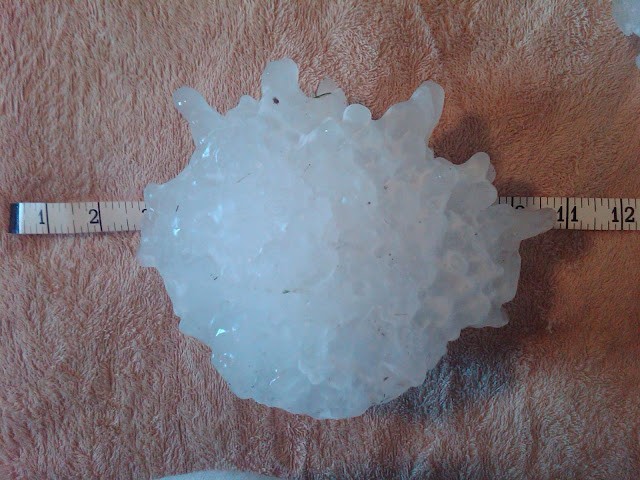While the threshold for hail to be considered severe in size is a quarter-inch diameter (the size of a quarter), many have come down as big as a golf ball. So how and when exactly does hail form within a thunderstorm, and what determines the size?
 |
| The largest hailstone every recorded, measuring 8 inches in diameter. |
Droplets of water in a cloud get pulled upward by strong updrafts. An updraft occurs when hot air collides with cold air, causing the cold air to shift above the hot air. Hot air rises through the cold air (since hot air naturally rises), creating an updraft.
If the air towards the top of the cloud is below freezing, then the droplets freeze on each other. This forms a very small ice crystal. The frozen droplet will begin to drop but get pushed upward again because of the updraft. On the way up, the crystal comes into contact with other droplets of water, causing those droplets to freeze to it, increasing the size of the hailstone.
So what causes it to drop to the ground?
If the updrafts begin to fade away, the hailstone will no longer be forced back up to the cloud. This allows it to fall to the ground.
Sometimes, if it is really big or the updrafts are not very strong, the hailstone will be too heavy to keep in the cloud and will fall to the ground.
What determines its size?
Since hailstones are dependent on updrafts, if the updrafts are short-lived, then the hail will be small. On the flip side, if there are long-lasting and strong updrafts, thunderstorms can produce massive hailstones. The record is currently held by an 8-inch hailstone recorded and confirmed in Vivian, South Dakota on July 23, 2010. It weighed 1.9375 pounds.
Comments
Post a Comment
If you have questions or comments, feel free to leave your thoughts in the comments section provided. We only allow on-topic, constructive comments. Spamming, advertising for your business - even if concealed in an otherwise okay post - is not allowed.